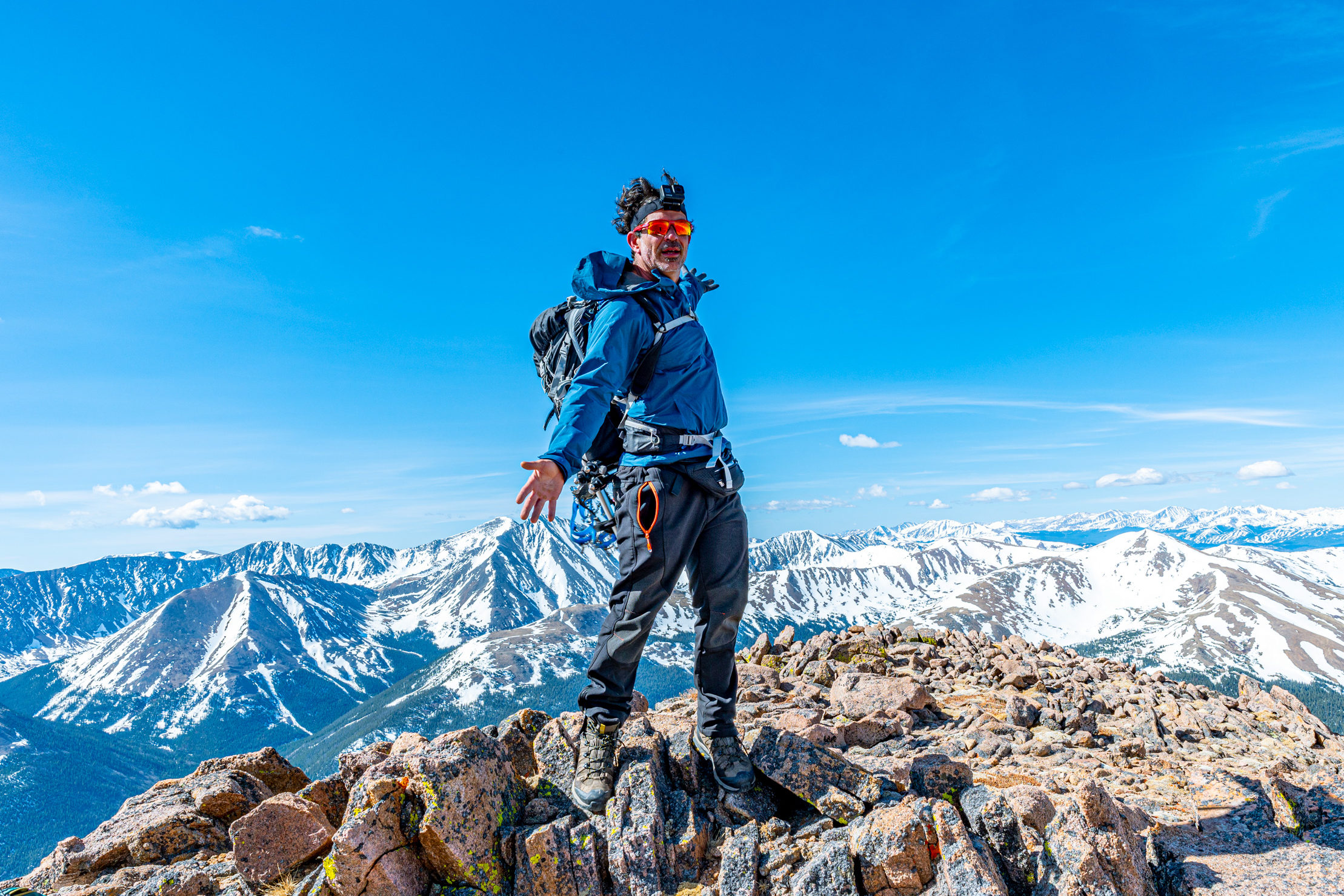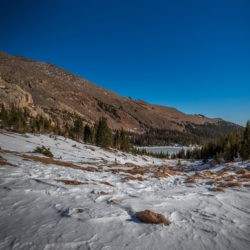
May 17th 2020 found us at the Watrous Gulch Trailhead just off 70 West; the plan was to summit Mount Parnassus, standing at 13,580 feet. Being right of I70, this is a great 13er to tackle because of the easy access.
We hadn’t been on this trail before and we arrived at the trailhead after sunrise. The parking lot has plenty of parking options and is easy to get to. In addition, both the Watrous Gulch Trail and the Herman Gulch trail are portions of the Continental Divide Trail, stretching 3,100 miles from New Mexico to Montana.
Check out the epic video we made of our hike to Mount Parnassus Summit
There was plenty of snow lingering on the trail and it was necessary to pack traction and snow gear. However, we opted to leave the snowshoes at home to shed pack weight which turned out to be a mistake on our part later in the morning.
The first leg of the trail went without a hitch; the trail was dry and easy to navigate. Around the mile mark we encountered deep snow. On the ascent the snow was a non-issue, as it was still chilly in the early hours and we could walk on top of the snow without postholing.
 The snow did make it difficult to stay on route and there were footprints everywhere that were misleading. We spent a good portion of the next mile breaking our own trail up to the saddle. While not particularly cold, the snow was blinding and protective eye wear was a must have.
The snow did make it difficult to stay on route and there were footprints everywhere that were misleading. We spent a good portion of the next mile breaking our own trail up to the saddle. While not particularly cold, the snow was blinding and protective eye wear was a must have.
 The conditions became increasingly windy after reaching the saddle. We had not been following a trail for most of the hike up and this trend continued up to the summit of Parnassus Peak. It was easy to see how to approach our summit destination, which essentially meant hiking straight uphill.
The conditions became increasingly windy after reaching the saddle. We had not been following a trail for most of the hike up and this trend continued up to the summit of Parnassus Peak. It was easy to see how to approach our summit destination, which essentially meant hiking straight uphill.
Until this point we thought we were the first group on the trail but on closer inspection we did see two single hikers and one dog above us. After a seemingly endless upward journey, we reached the summit of Mount Parnassus, a total elevation gain of 3,500 feet.
Mount Parnassus Summit
The views of the surrounding peaks in the Front Range was breathtaking and were a great backdrop for photography compositions. The wind wasn’t as bad as it was in the saddle, but there were still come heavy 30mph gusts here and there.
 If your looking for a great sunrise photography location without hiking a 14er, this would make a great option. It’s not as strenuous as most 14ers and very easy trailhead access.
If your looking for a great sunrise photography location without hiking a 14er, this would make a great option. It’s not as strenuous as most 14ers and very easy trailhead access.
Mt Parnassus Bard Peak Traverse Fail
We decided to make our way towards the adjoining Bard Peak measuring 13,646 feet. This trek involved walking across a traverse that had some snow patches but was otherwise bare. If we would have made it, it would have added 2 miles RT and 500ft of elevation gain.
After hiking about one third of the distance to Bard Peak we decided to turn back. At this point it was around 10AM and we were nervous about incoming weather.
We re-summited Mount Parnassus then began our descent. The downhill portion was killer on our knees and we were glad to get back to more level ground. Upon reaching the snowfield, we strapped on our microspikes once more. Conditions in the snow had changed drastically in the warming temperatures; it was now a postholing nightmare.
You should always bring snowshoes in early spring at high elevation
We immediately regretted the choice to forgo the snowshoes, though we could see from footprints that even hikers with snowshoes were postholing at times. It felt as if we could hardly go 6 feet without falling in a hole knee to waist deep. This part of the hike was frustrating and we were both tired, but eventually we made it back to the dry Watrous Gulch Trail. It was a quick downhill trek back to the parking lot.
 We spent 6 hours and 20 minutes on the Mount Parnassus hike that totaled 7.5 miles in distance. Though there is no discernible trail up to Mount Parnassus, it’s fairly easy to navigate and one of the more rewarding hikes close to Denver.
We spent 6 hours and 20 minutes on the Mount Parnassus hike that totaled 7.5 miles in distance. Though there is no discernible trail up to Mount Parnassus, it’s fairly easy to navigate and one of the more rewarding hikes close to Denver.








Leave a Reply
You must be logged in to post a comment.